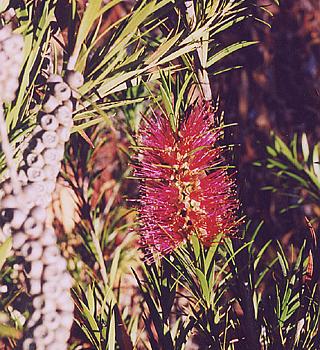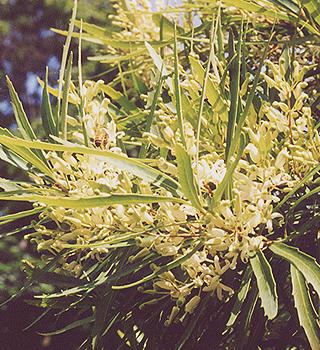|
[Front Page] [Features] [Departments] [Society Home] [Subscribe]

Australian Plants in Seattle
Randall Linke
Seattle, Washington, USA, is not resplendent with Australian plants. The climate is attuned to the classic English cottage garden, which for decades has been the preferred style. Arriving here in 1995 from California, where I had a small specialty nursery, it was my expectation that growing Australian plants in this new region would prove a challenge. I quickly realized however that there are many South African and Mediterranean plants here and began to wonder why Australian species, particularly those from Victoria and Tasmania, had not made their way into the local garden palette.
Only one regional nursery regularly offers a limited selection of Australian plants, all Tasmanian conifers. Heronswood Nursery, under the direction of noted local horticulturist Dan Hinkley, offers six species or cultivars of Athrotaxis, Lagarostrobos, Microcachrys, and Podocarpus. We share the view that there has been a wealth of classic 'Cottage Garden' material in the local trade, and it has been only recently that a more experimental interest has developed in the area.
This region has experienced an influx of people from other climates, largely as a result of the technology boom, powered locally by Microsoft. This in turn has created a demand for more diversity and individuality in garden design. This explains the introduction of a number of plants that do not fit the traditional mode, but not the lack of Australian natives.
 |
|
Eucalyptus pauciflora
Photo: © Randall Linke |
|
Dan Hinkley's experience with Australian plants has been mixed. He states that many plants have failed to thrive, or develop quickly. Mostly he attributes this to our short summers, where only three months are predictably warm, with average high temperatures above 80oF (27oC). Rain is not uncommon in any month, and our winters are almost always dreary and moist.
At this writing Dan Hinkley is designing a garden utilizing a wide array of Australian plants on southwest Bainbridge Island, located across Puget Sound from Seattle. Specific details were not available as the project is under development, though the garden will include plantings of Grevillea and plants from Tasmania.
Other than the occasional Scaevola that appears in a pre-planted basket, I know of only one other nursery that has made an attempt to market Australian plants in this area. This past spring they imported a collection of species, including varieties of Baeckea and Grevillea, from California. Reports are that these plants were well received, but it seems likely that few of the species offered, most of which were from Western Australia, will succeed here, confirming a general belief by many residents that Australian plants are not suited to this region.
This attitude was succinctly expressed by Randall C. Hitchin, the collections manager at the Washington Park Arboretum in Seattle, who states: "The Washington Park Arboretum has made introductions of Australian plants over several decades - they are not exceptional and we lose them during our more 'unpleasant' winters".
Yet aside from the occasional specimen of Eucalyptus gunnii or, E.pauciflora subsp. niphophila growing in private gardens, the greatest variety of Australian plants to be found remain in the collection at the Washington Park Arboretum. The arboretum is jointly administered by the University of Washington's Center for Urban Horticulture, which is responsible for the collections, the City of Seattle Parks and Recreation Department and the Arboretum Foundation.
All of the arboretum's current plantings of Australian natives date from 1990, with the exception of one specimen of Eucalyptus gunnii from an earlier planting, dated 1957. This has re-sprouted from a stump of only 5cm diameter and currently barely exceeds 2 meters in height. That these species are suitably hardy can not be doubted. All survived an exceptional freeze in late 1995 which produced a full week where the overnight temperatures dropped as low as 16oF (-9oC) and never rose above freezing during the day.
The current collection at the Washington Park Arboretum includes the following:
| |
 |
| |
Callistemon linearis
Photo: © Randall Linke |
| |
 |
| |
Lomatia myricoides
Photo: © Randall Linke |
Mediterranean Climate Garden:
- Callistemon linearis
- Callistemon pallidus (source: Tasmanian Native Plant Society)
- Callistemon viridiflorus (source: Tasmanian Forest Seed)
Graham Visitors Center, Washington Park Arboretum:
- Callistemon linearis var. pumila
- Eucalyptus coccifera (source: Royal Botanic Gardens, South Yarra, Melbourne)
New Zealand and Chilean garden:
- Eucalyptus gunnii
- Lomatia myricoides
- Nothofagus gunnii
And planted at the Center for Urban Horticulture:
- Eucalyptus pauciflora (some labeled as E.paucifolia)
I have been able to locate only two other plantings of Australian natives in Seattle. These are two Grevillea victoriae, planted at the Hiram M. Chittenden Locks in Seattle, and an unknown callistemon, likely C.linearis, planted in the border of one of Seattle's Pea Patch community gardens.
All of these specimens predate the last big freeze. So it is likely that earlier species introduced were either killed in an exceptional winter, poorly sited, or truly unsuitable to cultivation here.
My experiments with Australian plants here have been limited. To date I have brought the following seedlings through one rather cold and snowy winter:
- Arthropodium milleflorum
- Blandfordia punicea
- Dianella tasmanica
- Eucalyptus cordifolium
- Eucalyptus perriniana
- Patersonia occidentalis (damaged but survived)
- Xyris operculata
There are many more species of Australian plants of horticultural interest deserving of a place in Seattle gardens. Hopefully the efforts of Dan Hinkley and others will produce an appreciation of Australian flora, leading to the introduction of a wider selection in local nurseries. It is clear that this selection must be undertaken with careful attention to local conditions that will require much trial and error by adventuresome growers. Fortunately, it appears that such a climate for experimentation can now be found in the Puget Sound area, which should result in the introduction of new varieties to the trade.

[Front Page] [Features] [Departments] [Society Home] [Subscribe]
Australian Plants online - December 2002
Association of Societies for Growing Australian Plants
|